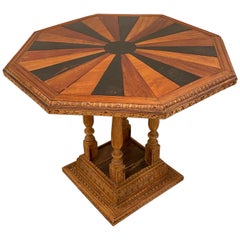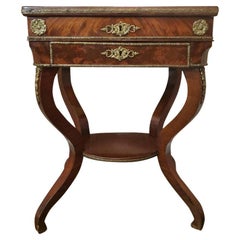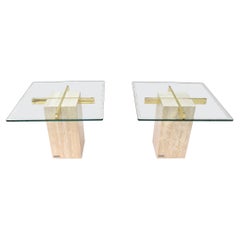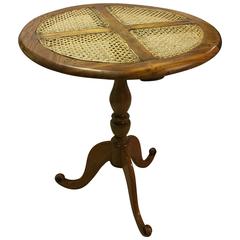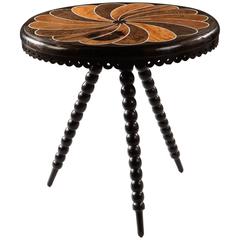Sri Lankan End Tables
2
to
1
1
2
2
2
1
1
1
Height
to
Width
to
Depth
to
2
2
1
1
1
796
3,952
3,334
3,027
1,371
Place of Origin: Sri Lankan
Pair of Circular Ceylonese Occasional Tables
Located in London, GB
A pair of 20th century ebony occasional tables with carved pedestal and tripod bases.
Category
Mid-20th Century Sri Lankan End Tables
Materials
Hardwood
19th Century Dutch Ceylonese Specimen Table
Located in Southampton, NY
19th century Dutch Ceylonese specimen table, circa 1890. Handmade in the Dutch style with a Ceylonese twist on the base in Sri Lanka. Various woods include: Nadoun, satinwood, mahoga...
Category
Late 19th Century Dutch Colonial Antique Sri Lankan End Tables
Materials
Ebony, Mahogany, Satinwood
Related Items
19th C. French Charles X Restoration Period Sewing Stand Work Table
Located in Forney, TX
A scarce period Charles X (1818-1834) French Restoration mahogany travailleuse sewing (thread stand - side table - jewelry dressing table) with light, warm, beautifully aged patina.
Born in France in the early 19th century, almost certainly Parisian work, exquisitely hand-crafted, this exceptionally executed example features ornate gilt bronze ormolu mounts, escutcheons, and elaborate gilt metal trim. Having a highly figured light mahogany hinged lid top, lifting open to reveal a striking finished interior with divided compartments and original inset mirror plate. The conforming rectangular case fitted with a faux drawer front over a dovetailed drawer with sectioned interior. Elegantly rising on oval-shaped medial shelf stretcher-joined curvacious legs.
Dimensions (approx):
27" High, 20" Wide, 13.5" Deep
Stunning light almost blonde antique mahogany coloring and mellow warm tone, superb wood grain detail, and charming, beautifully aged patina over the whole. Great shape overall. Retaining original antique character marks, wear consistent with age and indicative of minimal use, nothing that detracts from the aesthetics or functionality, but only adds to the overall authenticity, refined elegant warmth, luxurious sophistication, and cozy unpretentious rustic elegance.
Delivered cleaned, hand waxed, polished French patina finish, ready for immediate use and generational enjoyment!
What is Charles X style:
The comte d’Artois – or Charles X - was the son of the dauphin Louis-Ferdinand de Franc and Marie-Josèphe de Saxe. He succeeded his two brothers Louis XVI and Louis XVIII and became the King of France in 1824. Thirty years after the French Revolution, he wanted to embody the return of monarchy and became the leader of the catholic party . As the previous kings, he was crowned in 1825 but he was soon overthrown by the revolution in July, 1830, called "Trois Glorieuses". He left then for England, Scotland, Prague and Istria where he died in 1836.
Charles X style lasted from 1818 to 1834 and happened during the Bourbon Restoration (French Restoration). This style did not replace totally the style of furniture from the French Empire but it was different from the formalism in the Napoleonic era, during which strictness and simplicity were inspired by Greco-Roman art. Indeed, artistic fields flourished. In terms of furniture, this renewal was suggested by the softening of shapes. Even though the simple aspect from the French Empire was still visible, shapes became curvier with volutes and arabesques. Another distinction is the loss of the massive aspect of furniture and the decrease of dimensions in order to decorate smaller appartments. Handling ability and comfort were key-words in the making of furniture. Apartments had essential elements such as chests of drawers, big rounded tables in the dining room, desks or secretaries, armoires and even dressing tables, comfortable fainting couches in the living room, small tables, pedestal tables, as well as gondola chairs. The wavy aspect of the latters certainly represent Charles X style the best.
One of the most emblematic features of this style is the use of bois clairs – light woods in warm blond tones - and indigenous woods that are varnished in order to highlight the grains. Bird's-eye maple, ash trees, plane trees, yew trees, beech trees, olive trees and cedar trees were most likely to be used. Indeed, at the beginning of the 19th century dark woods were hard to find. In 1806, the Napoleon’s Continental System was established in order to ruin the United Kingdom by preventing the country from any business with the rest of Europe. Therefore craftsmen had to find alternatives from mahogany which was the most commonly used material at this time. After 1815, the import of wood was even more difficult because of peace treaties and the European political situation, which contributed to the popularity of the bois clairs and indigenous woods. The furniture was often decorated with fine inlays made out of dark wood representing foliage, which contrasted with the veneer. Even though these patterns can look like bronze decorations from the Empire era, they were far more simple and did not represent any military or mythological attributes. On the tables, trays were sometimes made out of marble as in the French Empire, but it was often put aside and inlaid veneer, Verre Eglomisé – a type of glass with a mirror finish –, mirror or porcelain from Sèvres or Paris were more likely to be used.
Decorative elements from the Monarchy were highly appreciated again as they suggested luxury. Indeed, marquetry work was particularly fashionable - Boulle marquetry thrived around 1820 as the works of the Levasseur family can show. In the same way, draperies and trimmings referred to the monarchist splendour. Fabrics were often white – the traditional colour of the Bourbons – or light coloured as oppposed to the typical green from the Napoleonic era.
One of the most symbolic figures from this period of time might be Jean-Jacques Werner (1791-1849), a cabinetmaker who worked for prestigious clients such as the Duchesse de Berry who was Charles’s step-daughter. His works can be seen at the Musée des Arts Décoratifs and at the Grand Trianon in the Palace of Versailles. The duchess’s appartments situated at the pavillon de Marsan and at the Palais de Saint Cloud illustrate Charles X style the best with furniture made out of bois clairs and ornamented with dark wood patterns or fine gold decorations.
Chales X style allows a transition between the sobriety of the Empire style and the abundant aspect of Louis-Philippe style. The gothic style started at this time through the "style à la cathédrale", inspired by religious architecture, which thrived from 1827 to 1830. Indeed, at the beginning of the 19th century, Romanticism put the spotlight on the Middle Ages. Cabinetmakers were not inspired by the medieval furniture but rather by architectural elements of churches and cathedrals. For instance the backs of chairs were decorated with arches shaped like rib and serration. In the same way, before Charles X abdicated, pieces of furniture were made out of dark woods – such as mahogany, which was used again in France – and were inlaid with light wood. Romanticism also influenced the layout of furniture in appartments to suggest movement through a mix of various styles, various shapes and various sizes, as opposed to the static aspect of Neoclassicism. The start of industrialisation and mechanisation also influenced this style as early technical developments led to the production of pieces of furniture in series.
Credit:
Marc Maison
Bibliography:
FANIEL Stéphane (Dir.), Le Dix-neuvième Siècle Français, Collection Connaissance des Arts, 1957, Hachette
SASSONE, Adriana Boidi, Furniture from Rococo to Art Deco, 2000, Evergreen
--
Extremely versatile:
As warm and attractive as it is useful, this remarkable antique table having the ideal size and small proportions for a variety of different uses, including as a side table, accent or occasional table, tall sofa...
Category
Early 19th Century Charles X Antique Sri Lankan End Tables
Materials
Bronze, Ormolu
Artedi Nero Travertine Marble Occasional Tables, Pair
By Artedi
Located in Southampton, NJ
A sculptural pair of tables by Artedi of the United Kingdom. Each table features Travertine marble base, subtle beveled glass top & inverted polished brass X support. Original Artedi...
Category
1980s Modern Vintage Sri Lankan End Tables
Materials
Travertine, Brass
A Pair of American of Martinsville Occasional Tables with Caned Shelf
By American of Martinsville
Located in St.Petersburg, FL
A pair of American of Martinsville occasional tables. Pull out drawer, caned shelf underneath. Walnut/black micarta tops.
Category
1960s Modern Vintage Sri Lankan End Tables
Pair of St. Charles Occasional Tables by Volk
By VOLK 3
Located in Brooklyn, NY
As shown: (Listing is for a pair).
Bleached ash with inlaid marble - sold individually or as a pair.
Copper plated steel leg
Waterborne finish.
Dimensions: 15.5” H x 20” W x 20”.
Cus...
Category
2010s Modern Sri Lankan End Tables
Materials
Marble
Pair of Steel and Ebonized Wood Circular Tables, Style of Osvaldo Borsani
By Osvaldo Borsani
Located in New York City, NY
A Minimalist pair of tulip design, splay leg end tables in steel and lacquered wood.
The austere and streamline design make this pair appealing...
Category
Mid-20th Century Mid-Century Modern Sri Lankan End Tables
Materials
Steel
Pair of Midcentury Light Mahogany Circular Side Tables by Robsjohn-Gibbings
By John Widdicomb, T.H. Robsjohn-Gibbings
Located in San Francisco, CA
A tailored pair of Robsjohn-Gibbings for Widdicomb each with round honey-colored mahogany top raised on quadrangular supports joined by a similar lower shelf.
Category
1950s Mid-Century Modern Vintage Sri Lankan End Tables
Materials
Mahogany
A Pair of Dunbar Occasional Tables Asian Style with Cork Tops
By Edward Wormley
Located in St.Petersburg, FL
An unusual and rare pair of side tables by Edward Wormley for Dunbar, circa 1940s. Mahogany with original cork tops, Asian Style with green Dunbar labels.
Category
1940s Chinoiserie Vintage Sri Lankan End Tables
Materials
Mahogany
19th Century French Bouillotte Table with Breche D'alep Marble Top
Located in West Palm Beach, FL
Bouillotte occasional table, having a round top of Breche D'alep marble, surrounded by a pierced gallery of brass, on mahogany table base, with double frieze drawers, and leather-cla...
Category
Late 19th Century Louis XVI Antique Sri Lankan End Tables
American Art Deco Circular Walnut and Brass Occasional / Side Table
Located in New York, NY
American Art Deco circular walnut table with four brass supports that angle inward to connect to a smaller bottom shelf resting on four square...
Category
20th Century Art Deco Sri Lankan End Tables
Materials
Metal, Brass
Pair of Asian Mid Century Octagonal Wooden Occasional End Side Tables
Located in West Hartford, CT
Pair of matching mid century Chinoiserie style octagonal tables with bottom shelving as well and pierced brass accents and pie crust marquetry at top.
Why not own the best?
Category
1960s Mid-Century Modern Vintage Sri Lankan End Tables
Materials
Brass
Lacquer Occasional Table
Located in Wilson, NC
Lacquer occasional table has highlights of gilt arabesques that surround a quatrefoil center panel framed with mother of pearl inlay. This p...
Category
1880s Antique Sri Lankan End Tables
Materials
Wood, Lacquer, Paint
19th Century Dutch Drop Leaf Table, Demilune Console
Located in Dallas, TX
19th Century Dutch drop leaf table ~ demilune console is one of the more unusual tables we've carried in the past three decades! Hand-crafted from solid planks and turned from solid ...
Category
Late 19th Century Dutch Colonial Antique Sri Lankan End Tables
Materials
Oak
Previously Available Items
Late 19th Century Sri Lankan Caned Satinwood Table
Located in Southampton, NY
Hand-Carved solid satinwood table with caned top, Sri Lanka, Colonial, circa 1890. Central pedestal with tripod base and hand caned top. Ebony detailing on scrolled feet. This piece ...
Category
Late 19th Century British Colonial Antique Sri Lankan End Tables
Materials
Ebony, Satinwood
Fine Specimen Wood Occasional Table
Located in London, GB
A fine late 19th century Sri Lankan specimen wood occasional table, with open fan design to the top, all supported on a tripod base.
Category
Late 19th Century Antique Sri Lankan End Tables
Recently Viewed
View AllMore Ways To Browse
Round Inlay Hall Tables
End Table Pair Blue
Quartersawn Oak
Quartersawn Oak Furniture
Ing Table
Vintage Mid Century End Table With Drawer
Pair Of Glass End Tables Round
Pair Of Baker End Tables
Antique Leather Lamp
Art Deco End Table Antique
End Tables Bamboo Vintage
Mahogany End Table 1900
Vintage Industrial End Tables
Vintage Two Tier End Table
Round End Table With Lamp
Pair Rattan End Tables
Laszlo Table Brown
French Empire Style End Table

